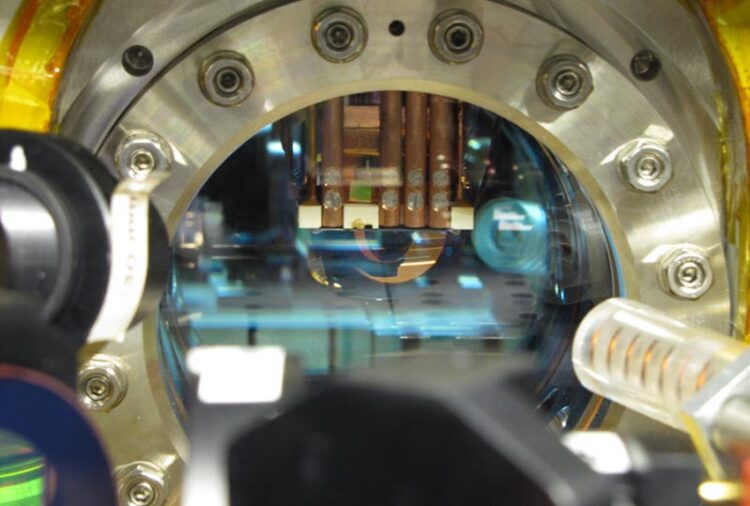Scientists have full state of a quantum liquid down cold

In the heart of the experimental setup sits the Atomchip in a vacuum chamber in Schmiedmayer lab at the Atominstitut of TU Wien in Vienna.
Credit: Thomas Schweigler
New research, using ultracold atoms, reveals particular properties of quantum systems.
A team of physicists has illuminated certain properties of quantum systems by observing how their fluctuations spread over time. The research offers an intricate understanding of a complex phenomenon that is foundational to quantum computing—a method that can perform certain calculations significantly more efficiently than conventional computing.
“In an era of quantum computing it’s vital to generate a precise characterization of the systems we are building,” explains Dries Sels, an assistant professor in New York University’s Department of Physics and an author of the paper, which appears in the journal Nature Physics. “This work reconstructs the full state of a quantum liquid, consistent with the predictions of a quantum field theory—similar to those that describe the fundamental particles in our universe.”
Sels adds that the breakthrough offers promise for technological advancement.
“Quantum computing relies on the ability to generate entanglement between different subsystems, and that’s exactly what we can probe with our method,” he notes. “The ability to do such precise characterization could also lead to better quantum sensors—another application area of quantum technologies.”
The research team, which included scientists from Vienna University of Technology, ETH Zurich, Free University of Berlin, and the Max-Planck Institute of Quantum Optics, performed a tomography of a quantum system—the reconstruction of a specific quantum state with the aim of seeking experimental evidence of a theory.
The studied quantum system consisted of ultracold atoms—slow-moving atoms that make the movement easier to analyze because of their near-zero temperature—trapped on an atom chip.
In their work, the scientists created two “copies” of this quantum system—cigar-shaped clouds of atoms that evolve over time without influencing each other. At different stages of this process, the team performed a series of experiments that revealed the two copies’ correlations.
“By constructing an entire history of these correlations, we can infer what is the initial quantum state of the system and extract its properties,” explains Sels. “Initially, we have a very strongly coupled quantum liquid, which we split into two so that it evolves as two independent liquids, and then we recombine it to reveal the ripples that are in the liquid.
“It’s like watching the ripples in a pond after throwing a rock in it and inferring the properties of the rock, such as its size, shape, and weight.”
An image and a video, along with captions and credits, depicting this process may be accessed from Google Drive.
This research was supported by grants from the Air Force Office of Scientific Research (FA9550-21-1-0236) and the U.S. Army Research Office (W911NF-20-1-0163) as well as the Austrian Science Fund (FWF) and the German Research Research Foundation (DRG).
Journal: Nature Physics
DOI: 10.1038/s41567-023-02027-1
Method of Research: Experimental study
Article Title: Verification of the area law of mutual information in a quantum field simulator
Article Publication Date: 24-Apr-2023
Media Contact
James Devitt
New York University
james.devitt@nyu.edu
Office: United States
Cell: 914-522-3774
All latest news from the category: Physics and Astronomy
This area deals with the fundamental laws and building blocks of nature and how they interact, the properties and the behavior of matter, and research into space and time and their structures.
innovations-report provides in-depth reports and articles on subjects such as astrophysics, laser technologies, nuclear, quantum, particle and solid-state physics, nanotechnologies, planetary research and findings (Mars, Venus) and developments related to the Hubble Telescope.
Newest articles

NASA: Mystery of life’s handedness deepens
The mystery of why life uses molecules with specific orientations has deepened with a NASA-funded discovery that RNA — a key molecule thought to have potentially held the instructions for…

What are the effects of historic lithium mining on water quality?
Study reveals low levels of common contaminants but high levels of other elements in waters associated with an abandoned lithium mine. Lithium ore and mining waste from a historic lithium…

Quantum-inspired design boosts efficiency of heat-to-electricity conversion
Rice engineers take unconventional route to improving thermophotovoltaic systems. Researchers at Rice University have found a new way to improve a key element of thermophotovoltaic (TPV) systems, which convert heat…



